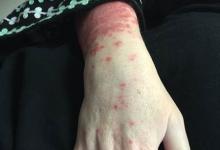Shingles Plus Autoimmune Disease Hikes Stroke Risk Save

Patients with autoimmune inflammatory diseases who develop herpes zoster are at increased risk of stroke for the subsequent 3 months, with risks diminishing thereafter, analysis of Medicare data showed.
In a multivariable adjusted analysis, the risk of stroke during the first 90 days after zoster diagnosis was increased by 36%, with an incidence rate ratio of 1.36 (95% CI 1.10-1.68), according to Jeffrey R. Curtis, MD, of the University of Alabama at Birmingham, and colleagues.
And among those with shingles-related cranial nerve complications, the risk in the first 90 days was increased by 76% (IRR 1.76 (95% CI 0.96-3.23), the researchers reported in Arthritis & Rheumatology.
The most common complication of herpes zoster is post-herpetic neuralgia, but in immunocompromised patients, more serious complications also have been observed, such as eye disease, vasculopathy, and cranial nerve palsy.
A series of epidemiologic studies in the general population has recently identified stroke as an additional serious complication of shingles, with risks being highest in the first few weeks.
To explore this risk in a particularly vulnerable population -- those with illnesses affecting the immune system -- Curtis and colleagues conducted a retrospective study of Medicare claims for the years 2006 to 2013 among patients with rheumatoid arthritis, ankylosing spondylitis, psoriasis, psoriatic arthritis, and inflammatory bowel disease.
Patients were categorized as having zoster with cranial nerve complications, with other complications, or without complications. "The rationale for this segregation relates to the known capacity for varicella to establish latency in cranial nerve ganglia, especially cranial nerve V, and spread retrograde via sensory nerve fibers to the cerebral circulation," the researchers explained.
Windows of risk included the first 90 days, 90 days to 1 year, and years 1 to 2.
The analysis included 43,527 patients, among whom 3,080 had cranial nerve complications, 4,494 had other complications, and 35,953 had no complications.
At baseline, ages in the three categories were similar (71 to 72), and three-quarters were women. Comorbidities included hypertension in more than half, hyperlipidemia in one-third, diabetes in 23%, and obesity in up to 10%. The most common autoimmune disease was rheumatoid arthritis, diagnosed in two-thirds.
About 20% were on biologic therapy, and slightly over 50% were on non-biologic disease-modifying anti-rheumatic drugs.
Among those with cranial nerve involvement, 70% received antiviral treatment, as did 56% of those with other complications and 80% of those without complications. Only about 5% had received zoster vaccination.
In the overall cohort, the crude incidence rate for stroke in the first 3 months was 1.24/100 person-years (95% CI 1.05-1.48) declining to 0.94/100 (95% CI 0.83-1.06) after a year.
The incidence rate in the overall cohort among those receiving antiviral therapy decreased from 1.13/100 (95% CI 0.92-1.39) after a year, while for those without antiviral treatment the rates decreased from 1.60 (95% CI 1.17-2.20) to 1.10 (95% CI 0.86-1.39).
In the subgroup of patients with cranial nerve complications, the incidence rates were 2.29/100 (95% CI 1.43-3.69) during the first 90 days, falling to 1.37 (95% CI 0.94-2) after a year. In that group, rates for those receiving antiviral treatment decreased from 2.29 (95% CI 1.30-4.04) to 1.14 (95% CI 0.70-1.87), and for those without treatment, the rates were 2.30 (95% CI 0.96) and 1.94 (95% CI 1.07-3.50).
Among patients with other complications, "patterns were similar but smaller in magnitude compared to those with cranial nerve complications," according to the authors. For example, in the overall cohort, incidence rates decreased from 1.68 (95% CI 1.06-2.66) in the first 90 days to 0.96 (95% CI 0.65-1.41) after a year. For patients without any complications, overall incidence rates were 1.10 (95% CI 0.90-1.34) and 0.90 (95% CI 0.78-1.03).
Most of the strokes were ischemic.
In the multivariable analysis, patients without complications had only a nonsignificant risk, with an incidence rate ratio of 1.26 (95% CI 0.99-1.60), but antiviral therapy was associated with a lower risk, with an incidence rate ratio of 0.83 (95% CI 0.70-0.98).
As to why zoster reactivation might lead to stroke, the researchers noted that they "have no pathologic data to help speculate on the immunopathogenic mechanisms involved, though a virally driven inflammatory and/or pro-coagulant effect is possible".
Further studies are urgently needed to identify those mechanisms, "given the implications of the large number of cases described and the implicit burden of morbidity and mortality linked to stroke," they stated.
Additional information is also needed about the use of the zoster vaccine in the immunosuppressed population. The 2015 American College of Rheumatology guidelines for the treatment of rheumatoid arthritis did not recommend that patients currently receiving biologics be given the live attenuated shingles vaccine, but a pilot study testing the vaccine in patients being treated with anti-tumor necrosis factor agents is underway.
A limitation of the study was its reliance on Medicare data and the lack of information about younger patients.










If you are a health practitioner, you may Login/Register to comment.
Due to the nature of these comment forums, only health practitioners are allowed to comment at this time.